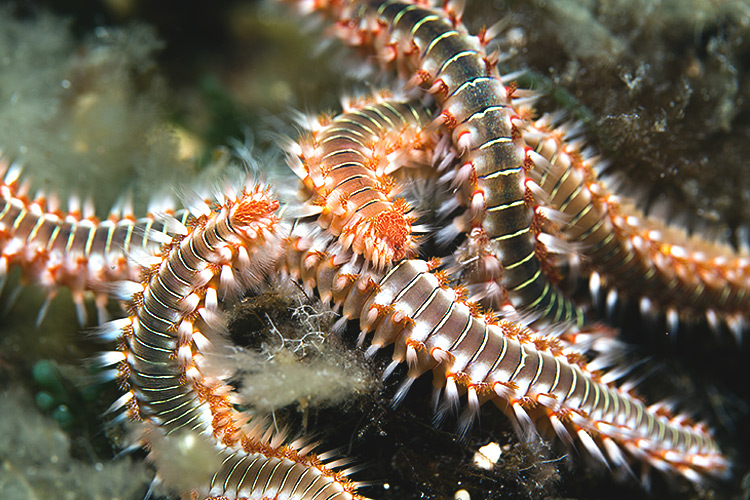Do you like worms? Unless you’re a fisherman, or a fish for that matter, worms probably aren’t on your list of enjoyable creatures. It’s no surprise the very mention of bristle worms send aquarium hobbyists into a tizzy.
Seemingly erupting out of thin air, bristle worms aren’t uncommon. In fact, almost every saltwater aquarium hobbyist will find these exotic worms wiggling in their reef tank at some point. When first noticed, your initial instinct may be to kill these foreign creatures as quickly as possible.
But wait!
Bristle worms aren’t marine demons sent to destroy your tank. Yes, they aren’t always the most beautiful inhabitant for your tank. But these creepy creatures can potentially act as a personal maid.
The reef tanks universe is just as complex as our own. It seems almost every creature, no matter how creepy, plays a role in balancing your aquatic ecosystem. So what’s the role of the notorious bristle worm?
Let’s find out ...

Author:
As a lifelong aquarist, Yuliya has an endless curiosity about our underwater universe. After graduating with a bachelor’s in Environmental Engineering, she transformed her passion into a successful career. While working at the Institute of Environmental Protection in Moscow, her passion for saltwater and reef aquariums only increased. Moving to the United States in 2013, Yuliya embarked on another impactful journey by sharing her unprecedented experience for all aquarium hobbyists ... Read More.
Behind the Stigma - Exploring Bristle Worm Types.
Think all bristle worms are the same? Think again! Like the other tank inhabitants, there are many different types, however, all belong to the Polychaete class of marine worms. With over 10,000 species, it’s a pretty crowded class.
Ever wondered why forum discussions tend to sway from proclaiming the wonders of bristle worms to calling for their immediate destruction? This topic can be confusing, but it doesn’t have to be. You simply need to know what type of bristle worm decided to call your pristine tank home.
Let’s start by correcting often misused terminology. To simplify, bristle worms is used to describe both good and bad species. While technically correct, it’s confusing when one person says to keep your bristle worms while another says to immediately get rid of them. This is when taking a few minutes to brush up on your marine biology comes in handy.
Bristle Worm - The Good Guys.
Remember learning how worms can regrow portion of their body that’s been damaged or torn away? This is because of its segmented biology. While bristle worms share this trait, that’s where its similarity to the common earthworm ends.
After seeing a bristle worm, it’s clear to see where its name came from. Covering its body are tufts of bristle needles. This is where you must be extremely cautious. Their tiny bristles penetrate your skin with ease, which can cause localized irritation.
As we’ll discuss later, some worm species carry toxins within its defensive armor. Always wear protective gear when dealing with good or bad bristle worms.
If left unchecked, bristle worms can grow up to 24-inches long! Okay, that doesn’t sound like an appealing notion, no matter how beneficial they may be. Thankfully, most reef tank bristle worms stay within a more manageable size of 1 to 6-inches long.
It’s not uncommon to have bristle worms for a while without ever noticing them. These nocturnal creatures only emerge from their rock or sand shelter when the lights are off. Have a tank with constant light? Then you may never see the worm until you start agitating its underwater landscape.
How To Spot a Good Bristle Worm.
This is the tricky part. The first step is actually seeing the worm. Turn the lights off in your tank and standby with your flashlight. Soon, it’ll appear out from behind a rock or from in the sand. If this doesn’t work, rustle sand with a net. When this visually interesting creature emerges, take note of:
- Evenly spaced bristle tufts along the sides of the worm.
- Brightly hued white bristles.
- Can have a colorful body or have a dull gray hue.
Aren’t sure what type of worm you’re dealing with? Take a photograph and head to your local aquarium store, or easier yet, post a photo of it in the comments of this article on our ReefHacks Facebook group page of your mystery guest.
The Bristle Worm Diet - What They Eat.
If you have a beneficial bristle worm, what should you feed it? Here’s the best part. Nothing! Well, that’s to say, you don’t need to specifically feed the worms a special diet.
Bristle worms are scavengers. This means they eat the leftovers made by other tank inhabitants and plants, which is also known as detritus. Ask any bristle worm what its favorite food is, and it’d reply, “fish poo, decaying/dead fish, leftovers from the last meal and other tasty debris.” Of course, if your bristle worm can talk, then stop reading and call a talent agent immediately!
For the rest of us, bristle worms act as a full-time maintenance crew. This creepy worker acts as a janitorial, waste management and landscaping crew. Along with eating the unsavory bits, they aerate your substrate and keep your tank surprisingly clean.
Are you afraid of keeping a bristle worm because it may overtake your reef tank? Don’t be. Typically, bristle worms only reproduce based upon food availability. An effective tip is being mindful of how much food you put in the tank. Overfeeding is the biggest factor in worm reproduction rates. Basically, if you don’t overfeed your tank, you won’t have bristle worm overpopulation issues.



Fireworms - The Bad Guys.
Fireworms are like that one cousin who shows up to the Christmas party late, drinks all the eggnog and asks if your New Year's resolution is to finally lose those 10 pounds. Essentially, fireworks are no good.
Be careful when discussing fireworms. Throughout the tank hobbyist community, some use this term to describe the good bristle worms. It comes down to the species. Bad fireworms hail from the Pherecardia, or Pacific, and the Hermodice, or Caribbean, species.
Classified as roving carnivores, fireworms are notorious for completely destroying tanks. Or, at least, damaging your favorite corals, or on a rare occasion, turn fish into midnight snacks.
Like its beneficial counterpart, fireworms have stinging bristles. But these aren’t just any defensive mechanism. Their bristles are toxic. If stung, get ready for a painful experience. Don’t rub. Place affected area in warm vinegar and let the bristle dissolve. Because fireworms are classified as carnivores, it features a strong jaw and is known for reproducing at astonishing rates.
To keep your tank healthy and happy, fireworms must be removed. We’ll get into proper removal and prevention techniques, but first, what does a fireworm look like?
The Bristles You Must Banish - Fireworm Identification Tip.
One of the first hints you’re dealing with a fireworm is that you actually see it. This aggressive species doesn’t always wait until dark to eat. If you suddenly see a worm with bristles emerge during feeding time, the chances are high that it’s a fireworm.
Much like good bristle worms, fireworms feature segmented bristle tufts along the side of its body. However, its coloration is often an easy way to determine its species. While it’s possible for variations, most tank fireworms have:
- Reddish color base along its bristles.
- White bristle tips.
- Red, yellow, brown or green gill filaments along its body.

The Fireworm Diet - What They Eat.
Fireworms are notorious for being aggressive predators, at least when worms are involved. They aren’t what you’d consider a picky eater. These worms tend to go for invertebrates, such as crustaceans, mollusks and corals.
Wondering whether you’re dealing with a fireworm? Closely inspect your corals. Fireworm jaws bite off the coral exterior and slowly lick away at its inner structure. Are your small fish numbers looking too low? You may have a fireworm. While rare, fireworms can target small fish.
As you can see, fireworms aren’t welcomed guests for any saltwater or reef aquarium. So how can you safely remove these prickly worms? In one word, carefully. For the expanded instructions, keep reading.
Worm Eviction - Safe and Effective Removal Techniques.
Obviously, if you have fireworms, the eviction process should start as soon as possible. While bristle worms do offer benefits, you may just not like knowing there’s a prickly worm hiding within your tank. Regardless, removal techniques are relatively easy. In our experience, there are several effective removal techniques, which include:
Manual Removal.
Warning: Freshwater dip is only for experienced reefers it can kill / shock more than just worms you need to know what you’re doing.
Have your live rocks turned into a bristle worm condominium? Evict these unwelcome tenants by carefully pulling the suspected rock out of tank and swiftly placing it in a bucket of freshwater. Make sure the water has been dechlorinated.
After a couple of seconds, worms are shocked out of their hiding places and end up at the bottom of the bucket. Before putting the rock back in your aquarium, closely inspect it for any stragglers. Detach stubborn worms by carefully picking them off with a pair of tweezers. Make sure to grab them in their center.
Bristle Worm Trap Kits.
Traps are an option if you’re looking for a passive way of removing bristle worms. These traps come in a variety of options, but are typically small acrylic or plastic containers with a small opening. Essentially, worms slither in, but due to its design, can’t escape. If you’er dealing with large worms, store-bought traps may not work. But it’s very easy to create a DIY trap at home and save money, here is an example, easy and effective:

Turning the Tables - Using Natural Worm Predators.
Often used as a last resort, predators literally eat away your problem. Predators, such as Wrasse from the Halichoeres family, Dottyback, Sunset Wrasse and Arrow Crabs enjoy bristle worms as prey. While this is an effective remedy, these creatures can or will also eat other crustaceans and inverts, please read about them in details before making the final decision.
Creating Your Perfect Tank Without Hassle.
While saltwater and reef tanks require a specific level of attention, the payoff is worth it. Although it can seem overwhelming, fixing bristle worm and fireworm infestations doesn’t have to be a complex situation.
Whether you’re looking for more information or want to learn more about the best traps, we’re here to help you along the way. Subscribe to our newsletter to access amazing giveaways, exclusive insider offers and regular updates!
by Yuliya Ivanova for ReefHacks.
Article Photography by Silke Baron - CC BY 2.0 License


